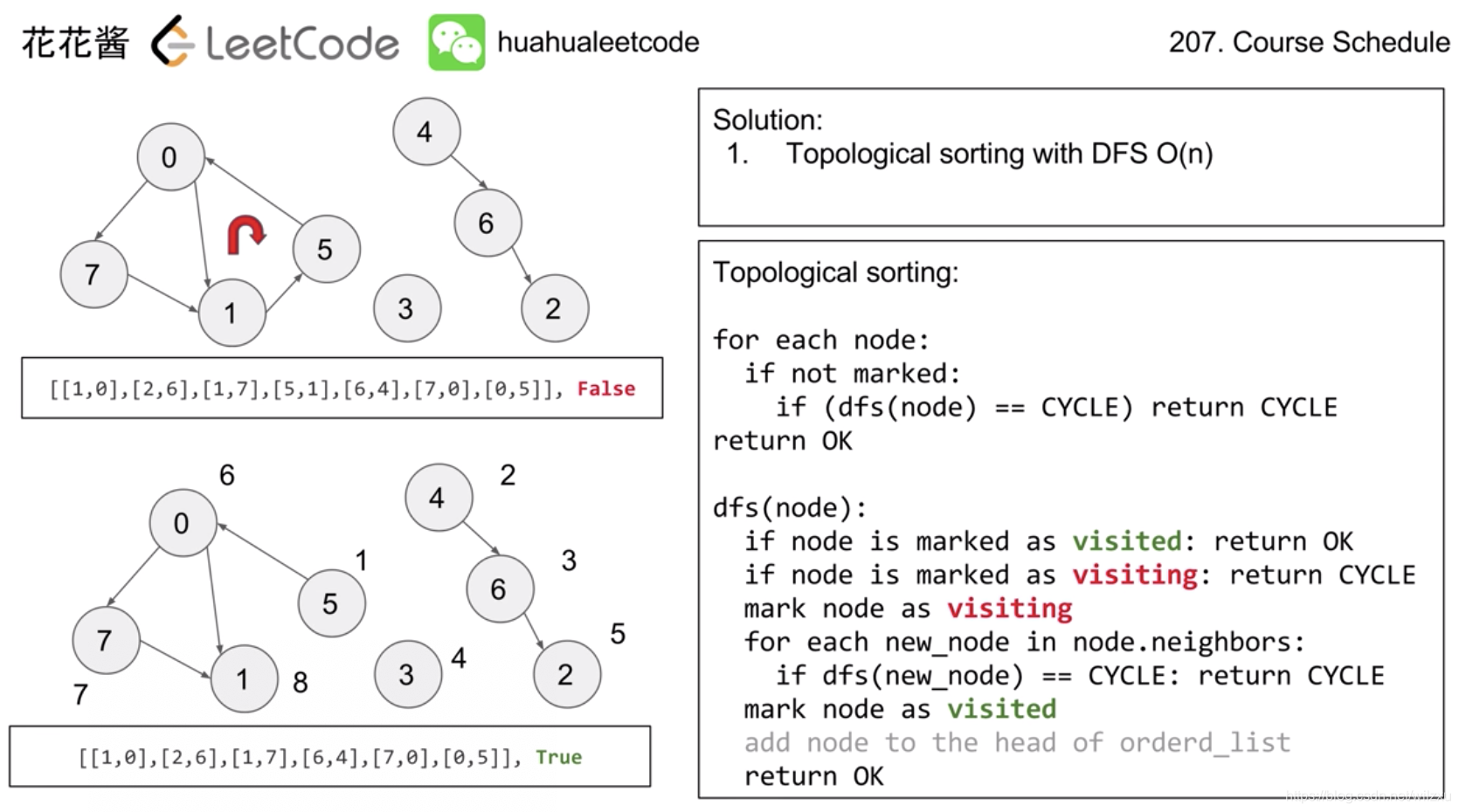207. Course Schedule
There are a total of n courses you have to take, labeled from 0 to n-1.
Some courses may have prerequisites, for example to take course 0 you have to first take course 1, which is expressed as a pair: [0,1]
Given the total number of courses and a list of prerequisite pairs, is it possible for you to finish all courses?
Example 1:
Input: 2, [[1,0]]
Output: true
Explanation: There are a total of 2 courses to take.
To take course 1 you should have finished course 0. So it is possible.
Example 2:
Input: 2, [[1,0],[0,1]]
Output: false
Explanation: There are a total of 2 courses to take.
To take course 1 you should have finished course 0, and to take course 0 you should
also have finished course 1. So it is impossible.
Note:
- The input prerequisites is a graph represented by a list of edges, not adjacency matrices. Read more about how a graph is represented.
- You may assume that there are no duplicate edges in the input prerequisites.
- There are several ways to represent a graph. For example, the input prerequisites is a graph represented by a list of edges. Is this graph representation appropriate?
Topological Sort via DFS - A great video tutorial (21 minutes) on Coursera explaining the basic concepts of Topological Sort. https://www.coursera.org/specializations/algorithms
Topological sort could also be done via BFS.
方法1: bfs
basketking: https://www.youtube.com/watch?v=zkTOIVUdW-I
思路:
根据hint,这道题的本质是探测有向图中是否有环,如果有环课程之间互相依赖,无法完成。如果没有环,按照拓扑排序即可上完所有课程。
因此这道题可以用bfs或者dfs完成。用一个向量来记录每一门课的入度,将入度为0的课推入队列。每次出队的时候将遍历所有它的后续课程并入度-1, 如果该课程入度变成0,则推入队列。入度初始化由遍历数组并建立map/vector来完成(这里每门课是int,不需要用hash,vector就可以)。直到遍历结束,队列为空,如果有节点的入度不为零,说明存在cycle,无法上完所有课,返回false。
需要的数据结构:
- vector<vector<int>> graph : 用来标示有向图,graph[1] : {2, 3} ,1是2,3 的先修课
- vector<int> : 每门课的入度
- queue<int>: 用来bfs遍历图
易错点:
- 为什么需要最后把入度再扫一遍:因为如果有相互dependency的话,谁也不会是0。
class Solution {
public:
bool canFinish(int numCourses, vector<vector<int>>& prerequisites) {
vector<vector<int>> graph(numCourses, vector<int>());
vector<int> degree(numCourses, 0);
queue<int> q;
vector<bool> visited(numCourses, false);
// 建立graph,注意先修课是a[1], [c1, prereq], [c2, prereq], [c3, prereq] ->{prereq: c1, c2, c3}
for (auto pair: prerequisites) {
graph[pair[1]].push_back(pair[0]);
degree[pair[0]]++;
}
// 推进所有入度为零(不需要先修课)的课程
for (int i = 0; i < numCourses; i++) {
if (degree[i] == 0) {
q.push(i);
}
}
// 遍历
while (!q.empty()) {
int top = q.front();
q.pop();
for (auto a: graph[top]) {
if (--degree[a] == 0) {
if (visited[a]) return false;
visited[a] = true;
q.push(a);
}
}
}
// 检查是否还有入度不为零的课
for (auto d: degree) if (d) return false;
return true;
}
};
方法2: dfs
huahua: https://www.youtube.com/watch?v=M6SBePBMznU
思路:
需要的数据结构:
- vector<vector> graph: 用来记录先修课
- vector<int> visited: 用来在dfs中标记status,0 = unvisited, 1 = visiting, 2 = visited

知识点: Topological order
Complexity
时间: O(n)
思路:
用dfs检测是否存在环,参考CLRS中拓扑排序的方式。与一般dfs不同的是需要设置三种状态,0 = unvisited, 1 = visiting, 2 = visited。只有当一个节点的所有子节点都遍历过,我们才将该节点标记为2,第一次遇到该节点,将其由0 变成1,所有节点初始化为0。
可以想象成一个栈来维持visiting的节点,当子节点都遍历过,我们将节点转移到visited的序列。这个visited的序列是按照修课的相反顺序,reverse之后就会得到一个topological ordered list。
易错点:
- 要遍历所有节点发起dfs,考虑到有孤立节点
- 注意bool的含义,这种解法标示的是“dfs中是否存在环”,主函数返回的是“能否完成所有课程”,意义相反
- 进入dfs前将visited[i] = 1, 遍历子节点结束后visited[i] = 2
- 注意这里被标记为visited的顺序与拓扑排序的顺序相反,后修课会先被visitied
- dfs循环中,任意一轮循环返回的是true,都要直接返回true
class Solution {
public:
bool canFinish(int numCourses, vector<pair<int, int>>& prerequisites) {
vector<vector<int>> graph(numCourses, vector<int>(0));
vector<int> visited(numCourses, 0);
for (auto a: prerequisites){
graph[a.second].push_back(a.first);
}
for (int i = 0; i < numCourses; i++){
// dfs 用来判断是否有环,或者t/f反过来代表是否能继续进行
if (dfs(i, graph, visited)) return false;
}
return true;
}
bool dfs(int i, vector<vector<int>>& graph, vector<int> & visited ){
if (visited[i] == 1) return true;
if (visited[i] == 2) return false;
visited[i] = 1;
for (auto j: graph[i]){
if (dfs(j, graph, visited)) return true;
}
visited[i] = 2;
return false;
}
};




















 456
456

 被折叠的 条评论
为什么被折叠?
被折叠的 条评论
为什么被折叠?








